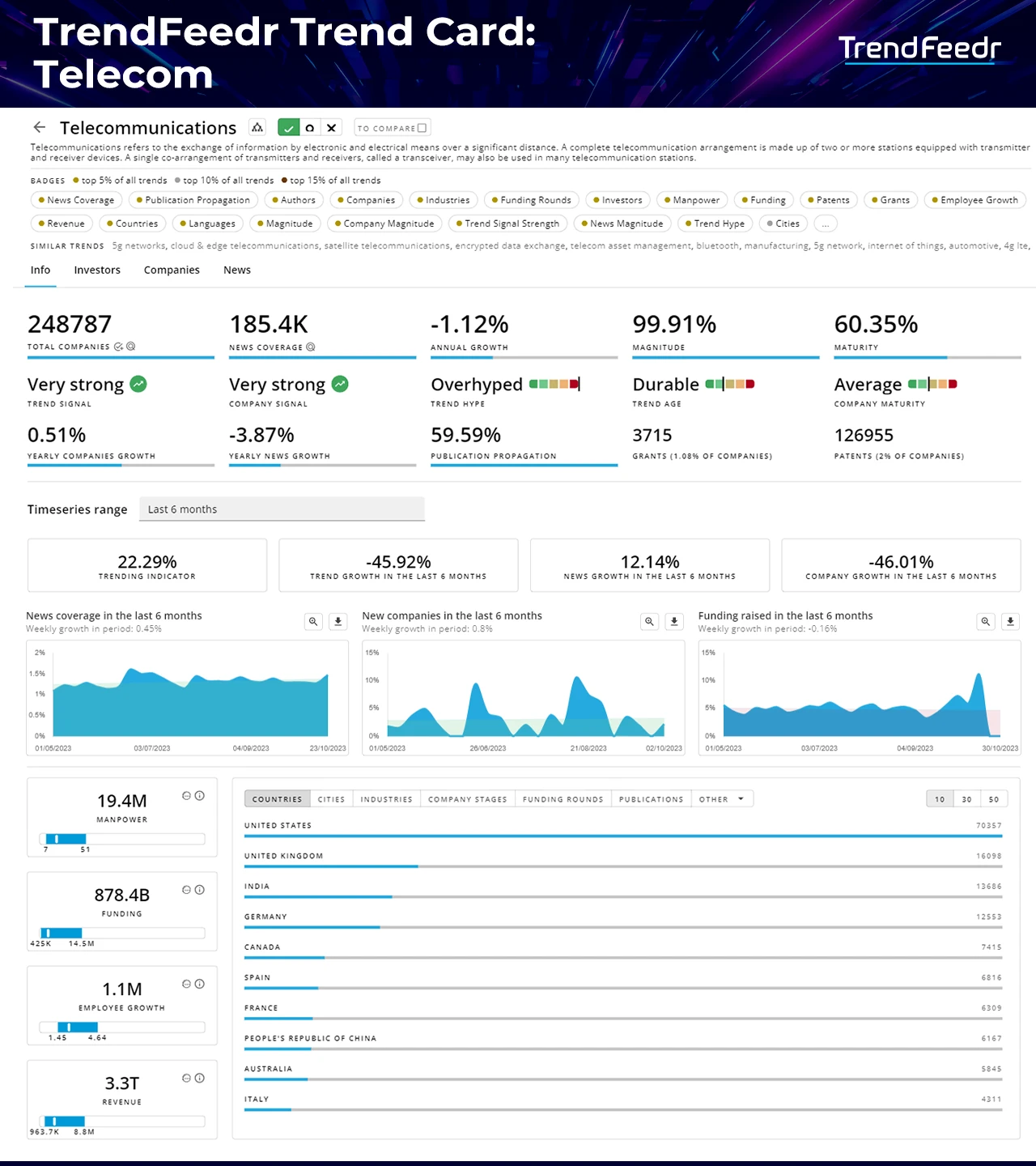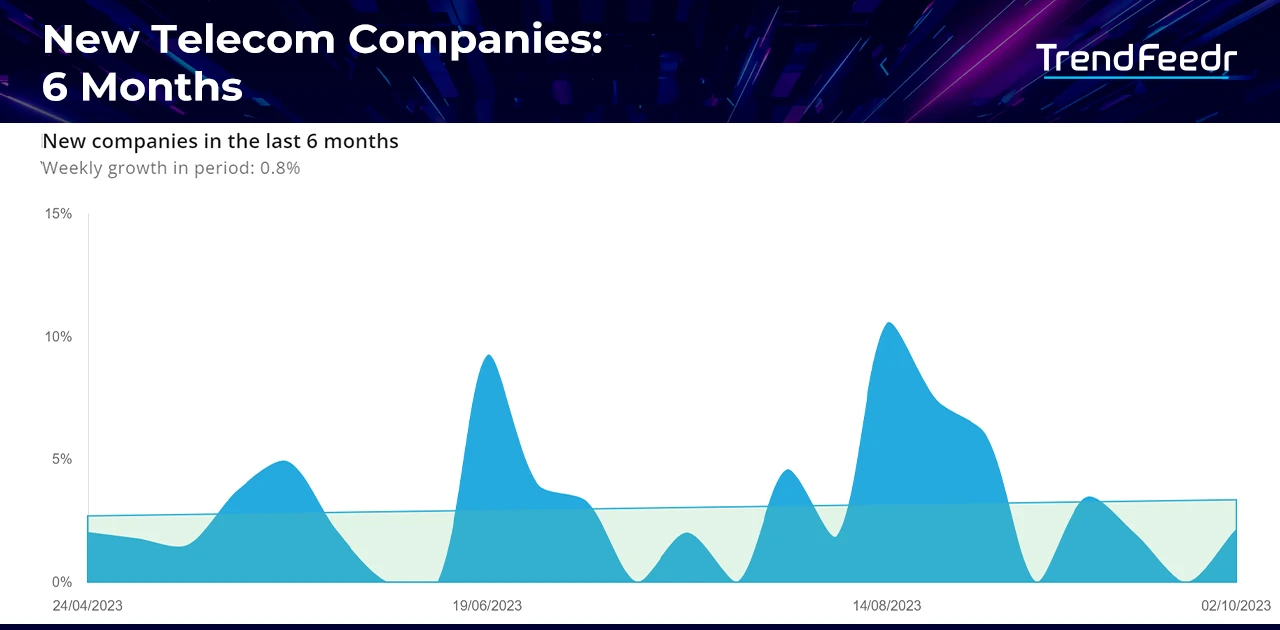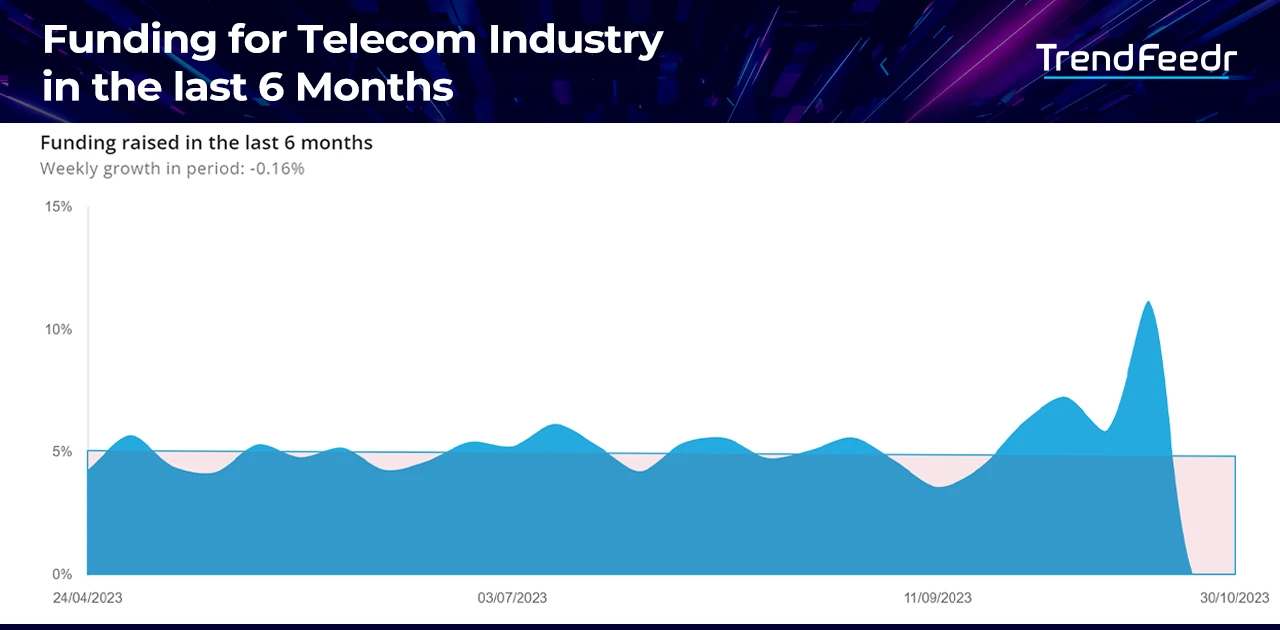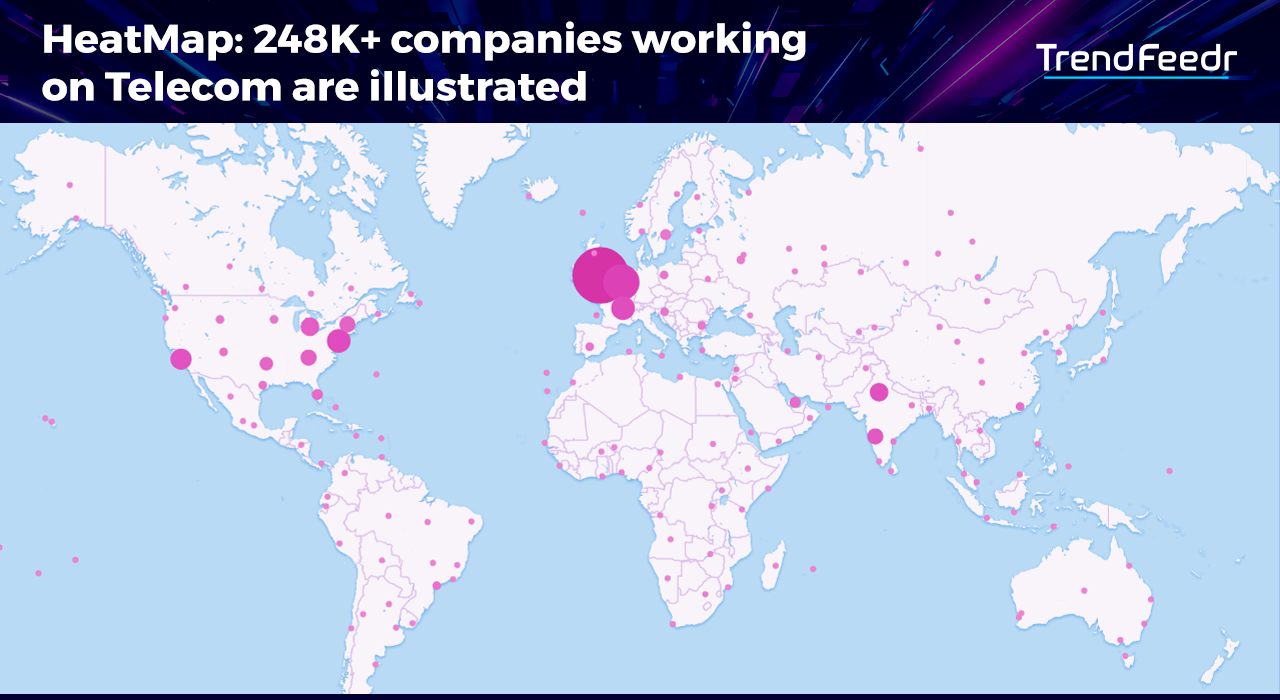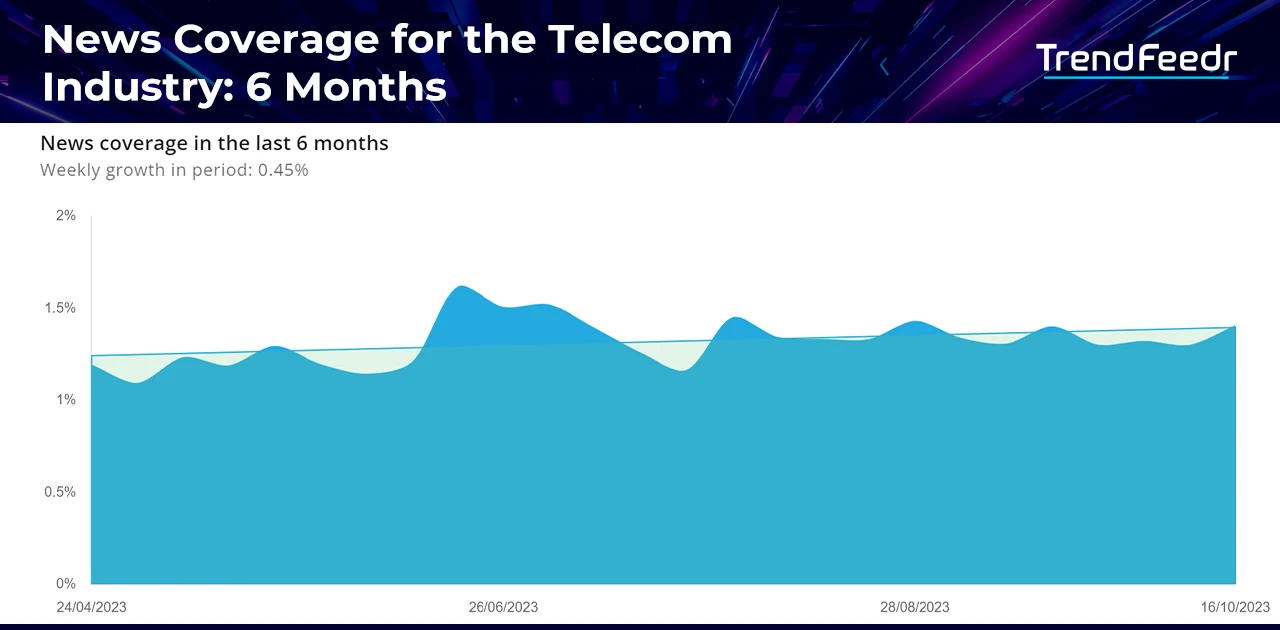The telecom trends report highlights current trends in the industry that are at the forefront of a global digital transformation. These trends drive innovations that offer unparalleled speed, reliability, and efficiency. A prime example of this is the bustling metropolis of Seoul, where the implementation of 5G technology has enhanced mobile connectivity and revolutionized various industries. It has facilitated the development of many Smart City solutions, such as intelligent traffic management systems and energy-efficient buildings, significantly impacting daily lives and the global economy.
Reflecting telecom market trends, the global telecommunication market is projected to grow from US$1805.61 billion in 2022 to US$3102.74 billion in 2030, according to Skyquest. This represents a compound annual growth rate (CAGR) of 6.2% from 2023 to 2030. Additionally, Statista predicts a substantial increase in fifth-generation (5G) subscriptions, rising from US$1.9 billion in 2023 to US$2.8 billion by 2024, and further to US$5.9 billion by 2027.
In this data-driven report, we delve into the current trends in the telecom industry, emphasizing 5G, satellite telecommunications, cloud & edge telecommunications, encrypted data exchange, and telecom asset management.
Key Takeaways
- Leading Trend: With a trend magnitude of 99.91% and a trend maturity of 60.35% according to TrendFeedr, the telecom industry is shaping the global communication landscape.
- Technological Diversification: Companies are actively broadening their horizons, embracing emerging trends in the telecom industry. This includes 5G, satellite telecommunications, cloud & edge telecommunications, encrypted data exchange, and telecom asset management.
- Elevated Media Visibility: Despite decade-long telecom industry news coverage decline, the last six months have shown a notable 0.45% weekly increase, signaling the industry’s rising prominence
- Robust Organizational Presence: The telecom industry comprises approximately 248,000 entities, collectively amassing funding of around US$878 billion, showcasing the sector’s financial vitality and investor confidence.
- Strategic Investors such as Insight Partners, SoftBank Vision Fund, and Warburg Pincus have channeled billions into innovative telecom ventures, thus fueling the industry’s growth and transformation.
- Global Hubs such as the United States, United Kingdom, India, Germany, and Canada are leading the wave in the telecom industry, along with cities such as London, New York City, Sydney, Shenzhen, and Bangalore advancing innovation in the telecommunication industry
Table of Contents
For this detailed analysis of telecom trends, we use TrendFeedr, our all-in-one trend intelligence platform. TrendFeedr uses advanced algorithms to identify future industry and tech trends. With a focus on trend discovery, clustering, and analysis, the AI-powered platform reviews thousands of trends each week to provide actionable insights.
Among more than 20,000 trends and technologies monitored by TrendFeedr, Telecom has made a significant impact. Here’s why:
- Telecom ranks in the top 20 trends and within the top 1% of global trends. This highlights its importance in shaping the digital landscape and facilitating real-time communication.
- With a trend maturity of 60.35%, the telecom industry comprises both well-established entities and thriving startups alike.
- The telecom industry is the backbone of global connectivity, enabling the rapid dissemination of information and innovation across diverse sectors.
This telecom trends report explores various aspects of the telecommunications industry trends, including performance, investment, regional activity, and future outlook.
Understanding Telecom Industry Trends
A series of transformative trends, propelled by the latest technologies, are reshaping the landscape of global communication. It is transforming the way we live, work, and connect. Let’s take an in-depth look:
What are trends in the telecom industry?
5G Adoption, one of the key telecommunication trends, is bringing us into a new era of speed, reliability, and connectivity. This trend supports everything from enhanced mobile broadband to IoT devices. Telcos are adopting cloud-based infrastructure to enhance their network scalability, ensure operational flexibility, and achieve cost efficiency. Further, edge computing enables data processing in the vicinity of the source, reducing latency and enhancing user experiences. The integration of AI and machine learning in network operations and customer service is increasing. It allows for analyzing network performance, predicting potential issues, and optimizing network operations. Moreover, in customer service, AI-powered chatbots and virtual assistants provide instant support and resolve customer queries with accuracy.
Due to the rise of cybersecurity threats, telecom operators are building robust and resilient network infrastructure. They emphasize encryption and secure communication. Satellite telecommunication has become an increasingly prevalent trend in the telecom industry. It plays a crucial role in achieving global connectivity, especially in remote and underserved areas. For instance, Starlink leverages a low Earth orbit and delivers broadband internet. It supports streaming, online gaming, video calls, and more. Lastly, telecom asset management involves strategic planning, tracking, and maintenance of an organization’s physical and digital assets, enhancing its efficiency and performance.
What are emerging technologies in the telecom industry?
Several technologies are disrupting the traditional telecom operations and shaping its future. Blockchain, with its secure and transparent nature, streamlines operations and reduces fraud. The decentralized ledger enables telecom operators to automate billing processes and manage contracts effectively. Further, robotic process automation (RPA) allows human resources to focus on strategic work by automating routine tasks and processes. This enables telecom operators to reduce their operation costs, eliminate human errors, and maintain a competitive edge in the market. Leveraging data analytics also empowers telecom operators to make data-driven decisions. This includes analyzing large sets of data for improving network operations, optimizing service delivery, understanding customer behavior, and identifying new revenue streams.
Telecom Industry Trend Card: A Comprehensive Snapshot of the Dynamic Telecom Landscape
Despite experiencing an annual growth decrease of 1.12%, the telecom industry demonstrates profound resilience and potential. It is boasting a remarkable 99.91% trend magnitude. This underscores its pervasive influence and paramount importance. Belonging in the top 1% of all global trends, it is reshaping the communication landscape. The trend maturity of 60.35% indicates a market that is both seasoned and ripe for innovation.
Looking for all trends related to telecom?
Here are more insights from the Telecom Trend Card:
- Industry Overview: With its vast landscape of 248,787 companies, the telecom sector stands as a colossal player in the global economy.
- Media & Publication: The sector has seen a ‘very strong’ media presence with 185.4K articles covered since 2005. However, a recent downturn is evident with a -3.87% yearly decrease in telecom news coverage.
- Patents: With 126,955 patents, the telecom industry showcases its dedication to innovation and technological advancement.
- Industry Dynamics: The sector is currently experiencing a notable shift, evidenced by a -45.92% decline in trend growth and a -46.01% decrease in company growth over the last six months, which could signal consolidation or market saturation.
- Investment Trends: Despite an overall strong funding history of US$878.4 billion, the sector has faced a -0.16% downturn in investment over the last six months.
- Employment & Revenue: The sector employs 19.4 million individuals and boasts a revenue of US$3.3 trillion, underlining the industry’s significant economic impact.
- Geographical Spread: The United States, United Kingdom, and India top the countries list, showing the global spread of telecom influence.
As we delve deeper into the subsequent sections, we will unravel these numbers and provide a clear picture of the telecom sector.
How do Emerging Technologies Disrupt the Telecom Industry?
The telecommunications industry driven by emerging technologies is paving the way for an interconnected, reliable, and innovative future. This section will explore these groundbreaking technologies in detail:
5G
5G, the fifth-generation technology standard for broadband cellular networks, is revolutionizing the telecom sector with its significantly faster data download and upload speeds. It offers reduced latency, and the ability to connect more devices simultaneously compared to its predecessors. It forms the backbone for enhanced mobile broadband, mission-critical communications, and the massive IoT.
Companies like 5G Tech Solutions are developing SDR (Software Defined Radio) and NB-IoT (Narrowband IoT) based wireless equipment. These types of equipment cater to both academic and industry needs. Their solutions include 5G protocol stack development and testing, LTE/VoLTE protocol testing, network traffic monitoring, and software-defined radio and networks.
Satellite Telecommunications
Satellite telecommunication technologies stand out as reliable communication solutions for their effectiveness in remote and underserved regions. These technologies are vital for achieving global connectivity. They are also at the forefront of technological innovation, especially with the incorporation of mmWave (millimeter wave) radio systems.
Paradigma Technologies offers mmWave radio systems for small satellites, CubeSats, and Satcom On-The-Move (SOTM) applications. Its product portfolio includes K band transmitters and Ka band receivers that integrate with modems, redundant transponders, and high-gain antennas, enabling next-generation satellite connectivity.
Cloud & Edge Telecommunications
Cloud and edge telecommunication technologies are redefining how data is stored, processed, and accessed in the telecom sector. They offer flexible and scalable solutions for communication services.
Companies like Astricloud provide cloud-based telecommunication and security services including VOIP phone systems, video conferencing, cloud contact centers, and smart security solutions. Baseband Telecom leverages edge telecommunication technology to provide fiber (advanced telecom technology), low voltage, and wireless services.
Encrypted Data Exchange
Today, data privacy and security have become paramount. Consequently, encrypted data exchange technologies have assumed a vital role in the telecommunications sector. They secure communications by encrypting texts, file sharing, and group chats, thus preventing unauthorized access.
Companies such as Cell Guard are pioneering in this field with products like Communicator. It is a secure messaging app that facilitates encrypted texting, file sharing, and group chats. Unlike conventional apps, all data transmitted via Communicator is end-to-end encrypted without being stored in the cloud, ensuring maximum privacy.
Telecom Asset Management
Efficient management of telecommunications assets is crucial for operational excellence and cost-effectiveness. Telecom asset management technologies assist businesses in tracking, managing, and optimizing their telecommunications assets throughout their lifecycle.
For instance, Sitehound offers telecom inventory management software that enables businesses to customize tracking fields, locate assets, and manage inventory by linking equipment to contracts. It also facilitates collaboration across supply chains and generates reports.
These emerging technologies are playing a crucial role in reshaping the telecommunications sector and guiding it toward unprecedented advancements. As these technologies continue to evolve, we can anticipate innovative breakthroughs that will redefine communication networks and services.
5 Key Telecom Industry Trends & Firmographic Insights
Telecom, employing a staggering 19.4 million individuals, is not just a significant employment generator but also a mirror reflecting the evolving technological landscape. With an average organization size of 112 employees, the industry illustrates large-scale operations, yet the median of 17 employees per organization paints a picture of a diverse ecosystem comprising both sprawling enterprises and nimble startups.
The annual workforce increase of 1.1 million individuals in telecom is a clear indicator of the sector’s vigorous growth and adaptation to new technological frontiers. This expansion is further clarified by the average growth per organization of 7 employees, with a median of 2, suggesting a spectrum of growth patterns across the industry. Some firms are scaling up modestly, while others are rapidly expanding, collectively contributing to the substantial growth in manpower.
Based on the latest data from TrendFeedr, explore the market dynamics driving five pivotal trends in the telecommunications industry, examining how each trend is shaped by and impacts key market indicators such as workforce size, funding levels, and organizational structures.
1. 5G
- 5G technology is bringing ultra-high-speed internet and more dependable network connections for mobile phones and other devices.
- An impressive 13.7K organizations are spearheading this revolutionary trend, amassing a substantial funding pool of US$94.5 billion.
- With a dynamic workforce of 1.3 million individuals, these organizations are redefining connectivity and communication in the digital era.
2. Satellite Telecommunications
- Providing global coverage and enhanced communication services, Satellite Telecommunications ensures connectivity even in the most remote areas.
- A total of 3,291 innovative organizations have embraced this trend, raising an impressive US$32.8 billion in funding.
- With a combined force of 288.1K committed experts, these organizations are leading the way in global telecommunications.
3. Cloud & Edge Telecommunications
- Cloud & Edge Telecommunications combines cloud computing with edge technology to deliver seamless and responsive telecom services.
- A total of 3,012 forward-thinking organizations are exploring this trend, collectively raising US$20.8 billion in funds.
- Supported by a team of 209K individuals, these entities offer innovative solutions for faster and more reliable telecom services.
4. Encrypted Data Exchange
- Ensuring secure communication within the telecom sector, the Encrypted Data Exchange trend protects sensitive information from unauthorized access.
- An influential group of 1,778 organizations is championing this trend, attracting robust funding of US$5 billion.
- Supported by 88.1K professionals, these entities are dedicated to enhancing the security and privacy of telecommunications.
5. Telecom Asset Management
- Telecom Asset Management focuses on optimizing the performance and lifecycle of telecom resources, thereby ensuring efficient operation and service delivery.
- A total of 103 progressive organizations have ventured into this domain, securing an impressive funding of US$420.7 million.
- With a cohesive team of 7.6K professionals, these institutions are at the forefront of streamlining telecom operations and asset utilization.
To ensure continuous growth and enduring robustness, it is crucial for industry participants and businesses to meticulously examine top trends in the telecom industry, strategically allocate investments, and skillfully navigate the associated challenges.
Emerging Telecom Companies Leading The Way
The time series chart shows a weekly growth rate of 0.8% in the last six months. This indicates a steady and progressive increase in the number of new entities within the industry.
5 Promising Telecom Startups
Moreover, telecom startups are at the forefront of the digital revolution. They are offering groundbreaking telecom technology solutions that are transforming connectivity, data handling, and user interaction. These startups are tackling key issues in the industry, from advanced wireless networks and edge computing to IoT incorporation and cybersecurity. Let’s explore five of the most impactful telecom startups founded in the last five years and their contributions to the evolution of telecommunications:
- Firecell provides turn-key 5G network solutions for enterprises, offering more robust connectivity than WiFi for large indoor spaces like factories and warehouses.
- Meshii WiFi builds a decentralized network of internet gateway devices that creates a large-scale public WiFi network in urban areas.
- Ikue develops a customer data platform designed for telecom companies, bringing customer data from different systems into a single view in real-time.
- Vraimatic provides robotic process automation (RPA) solutions to help telecom businesses streamline processes and increase productivity.
- Clientain creates a unified communications platform that boosts customer engagement rates by providing interactions via phone, SMS, chat, pay, and more.
Telecom Industry Investment Trends
The telecom’s funding ranks within the top 5% of all 20K+ trends, underscoring the industry’s resilience. This is a clear indication of the significant trust that investors have in telecom technology companies.
Examining the time series chart, we observe a downward trend. There’s a weekly growth rate of -0.16% over the preceding six months. This underscores the enduring allure of the industry to investors and its ability to secure financial support amidst fluctuating economic conditions.
Insights into Telecom Financials
According to data from TrendFeedr, the telecom industry has attracted significant total funding of US$878.4 billion. The funding amounts vary, with the largest single investment reaching US$3.6 billion. The average funding amount is US$42.7 million and the median funding is US$2.4 million. This range reflects a balanced blend of high-value investments and smaller, more frequent funding instances, demonstrating the industry’s wide appeal to investors of different capacities.
In terms of revenue, TrendFeedr estimates the telecom industry has an impressive total of US$3.3 trillion, indicating its vast size and profitability. The highest revenue generated by a single entity is US$2 billion. The average revenue is US$18.6 million and the median revenue is US$2.6 million across all entities. These figures not only highlight the financial strength of the telecom sector but also emphasize the substantial returns it provides, attracting further investments and talent.
Interestingly, 8.27% of telecom companies have received funding. Looking at the funding rounds, it’s important to note the variety in the types of funding attracted by the industry. The main types of funding include seed, early-stage VC/series A, venture round, M&A, and later-stage VC/series C, each contributing significantly to growth and innovation. Grants also make up a considerable portion of the funding landscape, with 3,715 grants awarded to 1.08% of telecom companies.
Prominent Investors in the Telecom Industry
Insight Partners, a prominent figure in the investment landscape, has invested a sum of US$2.4 billion, distributed across 36 companies. This demonstrates their commitment to nurturing innovation in the telecom sector. Their investments include US$270 million in Plume and US$40 million in Prisma Photonics, highlighting its faith in the transformative potential of telecom.
SoftBank Vision Fund, a powerhouse in the investment world, has allocated US$2.3 billion to the telecom industry, carefully selecting 9 companies for their investments. Their substantial investments include US$500 million in Cambridge Mobile Telematics and US$200 million in Wiliot, reflecting their strategic approach to support companies with the potential to reshape the telecom landscape.
Following closely, Warburg Pincus has invested a substantial US$2.1 billion in the telecom sector, spreading its funds across 22 different companies. This strategic approach has established them as a key player, with significant investments, including US$294 million in Bohao and US$250 million in Converge.
The public sector has also made significant contributions, with an astounding US$15.6 billion invested across 362 companies, with Hubei Zhongyi Technology receiving maximum funding of US$416.8 million. This demonstrates the extensive support the industry receives from governmental and public entities.
The European Investment Bank has committed an impressive US$3.4 billion to 20 companies within the telecom sector. Their significant investments include US$497 million in Telefonica and US$496 million in Proximus, showcasing their commitment to advancing the industry by providing crucial funding to companies with high growth potential.
The appeal of the telecom industry extends to a diverse range of investors, as evidenced by its position in the top 5% for unique investors among all trends.
Mapping the Geographical Activity of Telecom Companies
The heatmap below provides an overview of the trends in the telecom industry, featuring around 248,000 companies that are spearheading progress in the sector.
Interested to explore all 248K+ telecom companies?
The United States and Germany have consistently been strongholds in the telecom industry, with a mature market and numerous technological advancements. They lead the sector, offering robust infrastructures that encourage ongoing innovation. However, it’s in the dynamic markets of India and Canada where we see a wave of activity and growth. India’s swift economic progression and rising internet usage have thrust it into prominence, making it a fertile environment for telecom progress. Concurrently, Canada, with its unwavering dedication to technology and innovation, has shown steady and significant growth, cementing its place in the global telecom sphere. The United Kingdom has seen a more modest rise in telecom activities, reflecting a saturated market and the necessity for strategic innovation to sustain momentum.
On a city level, London and New York City continue to exert their influence, hosting a multitude of global telecom giants and startups. London’s strategic geographical position and New York City’s standing as the world’s financial center have both significantly contributed to its dominance in the telecom industry. Cities such as Bangalore, Shenzhen, and Sydney are witnessing intriguing shifts and developments. Bangalore has surfaced as a hub for telecom innovation, drawing talent and investments from around the world. Shenzhen has established itself as a global frontrunner in telecom, home to some of the world’s most influential companies in the sector. Sydney offers a stable and mature market for telecom companies to operate in, exemplifying the diverse nature of the global telecom landscape.
Media Coverage for Telecom Industry Sees a Weekly Uptick of 0.45% Over the Last Six Months
In the past six months, there has been a noticeable weekly growth of 0.45%. This demonstrates a steady and incremental increase in the media’s interest in and coverage of this sector.
The telecom industry ranks in the top 5% in terms of growth in publication coverage. This reflects a rapidly escalating interest and examination of this sector in both academic and professional environments. It also garners substantial attention, with 184,657 articles written between 2005 and 2023, placing it in the top 5% of all trends.
What is the Future of the Telecom Industry?
Looking ahead, the future of the telecom industry appears to be nothing short of transformative. The patterns, trends, and financial support we’ve analyzed thus far collectively depict a future characterized by robust growth, innovation, and transformative potential. Here’s more on the telecom industry outlook:
Technological Prowess and Innovation
The industry stands on the brink of a technological revolution. Advancements like 5G networks, IoT integration, and AI-driven solutions are setting the stage for unparalleled connectivity and efficiency. This digital transformation will enhance operational capabilities across various sectors. It will also give rise to new business models, unlocking new possibilities in service delivery and customer engagement.
Global Connectivity and Market Expansion
The relentless pursuit of global connectivity will continue to overcome obstacles. Furthermore, emerging markets will play a crucial role in the industry’s growth. The influence of the telecom sector will extend to even the most remote regions, bridging digital gaps and promoting economic development.
Cybersecurity and Resilience
In the current digital age, the necessity for network operators to bolster their defenses against cyber threats and volatile market conditions is of utmost importance. Consequently, Telcos, which form the critical infrastructure for a wide array of digital services, are increasingly susceptible to criminal attacks. This calls for constant vigilance and forward-thinking strategies to protect the integrity of telecommunication networks and the multitude of services they support.
Sustainable and Responsible Growth
As the industry expands so does its responsibility toward sustainable practices. The future will witness an increased emphasis on green technologies, energy efficiency, and responsible resource use, ensuring that the growth of the telecom sector aligns with environmental conservation.
Policy and Regulation
Navigating the intricacies of global policies and regulations will be essential for the telecom industry. Therefore, the industry must remain flexible, adapting to changing legal landscapes. This approach ensures compliance and, crucially, fosters an environment conducive to innovation and growth.
Telecom Trends: Navigating the Next Wave of Connectivity
As we wrap up the telecom trends report, it is clear that we are moving through a rapidly changing landscape. The pace of discoveries is fast, and the range of possibilities seems endless. Keeping up with these changing trends is very important. It allows you to anticipate changes, take advantage of new opportunities, and stay ahead in a field that is shaping the future of technology. But how do you do that?
Connect with telecom enthusiasts, industry leaders, and innovative creators; their insights can provide valuable perspectives and open up opportunities for collaboration. Dive into reports specific to the sector, attend telecom-focused seminars and conferences, and participate in online telecom communities. Also use trend-tracking tools like TrendFeedr, which meticulously tracks up to 571 sub-trends, offering a comprehensive view of the evolving telecom landscape.


